HYUNDAI TUCSON 2014 Owners Manual
Manufacturer: HYUNDAI, Model Year: 2014, Model line: TUCSON, Model: HYUNDAI TUCSON 2014Pages: 542, PDF Size: 7.59 MB
Page 521 of 542
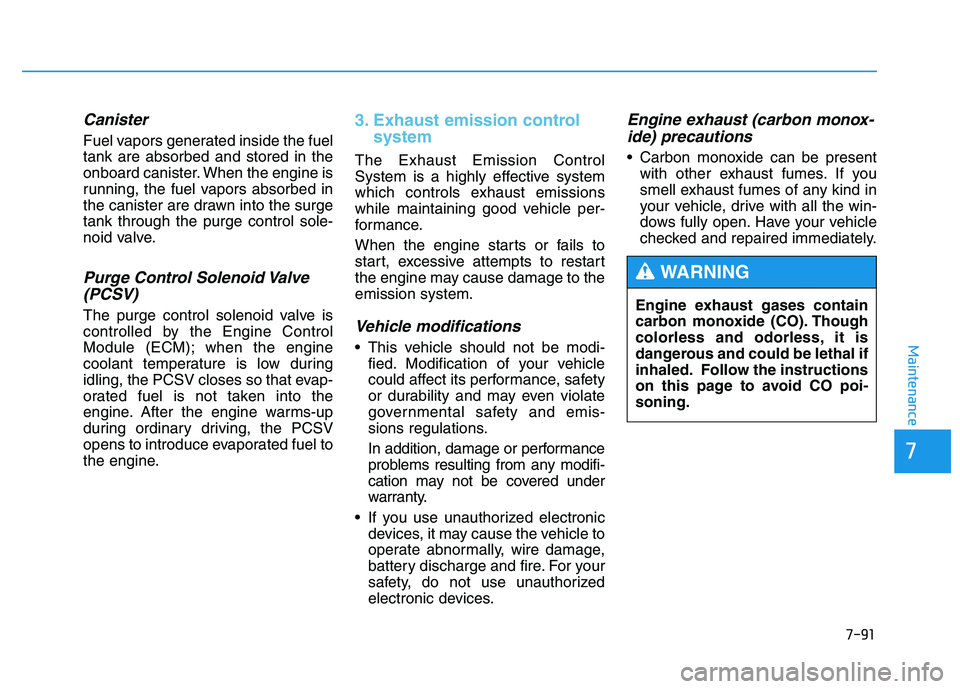
7-91
7
Maintenance
Canister
Fuel vapors generated inside the fuel tank are absorbed and stored in the
onboard canister. When the engine is
running, the fuel vapors absorbed in
the canister are drawn into the surgetank through the purge control sole-
noid valve.
Purge Control Solenoid Valve(PCSV)
The purge control solenoid valve is
controlled by the Engine Control
Module (ECM); when the engine
coolant temperature is low during
idling, the PCSV closes so that evap-
orated fuel is not taken into the
engine. After the engine warms-up
during ordinary driving, the PCSV
opens to introduce evaporated fuel to
the engine.
3. Exhaust emission control system
The Exhaust Emission Control
System is a highly effective system
which controls exhaust emissions
while maintaining good vehicle per-
formance.
When the engine starts or fails to
start, excessive attempts to restart
the engine may cause damage to theemission system.
Vehicle modifications
This vehicle should not be modi-fied. Modification of your vehicle
could affect its performance, safety
or durability and may even violate
governmental safety and emis-
sions regulations.
In addition, damage or performance
problems resulting from any modifi-
cation may not be covered under
warranty.
If you use unauthorized electronic devices, it may cause the vehicle to
operate abnormally, wire damage,
battery discharge and fire. For your
safety, do not use unauthorized
electronic devices.
Engine exhaust (carbon monox-
ide) precautions
Carbon monoxide can be present with other exhaust fumes. If you
smell exhaust fumes of any kind in
your vehicle, drive with all the win-
dows fully open. Have your vehicle
checked and repaired immediately.
Engine exhaust gases contain
carbon monoxide (CO). Though
colorless and odorless, it is
dangerous and could be lethal if
inhaled. Follow the instructions
on this page to avoid CO poi-soning.
WARNING
Page 522 of 542
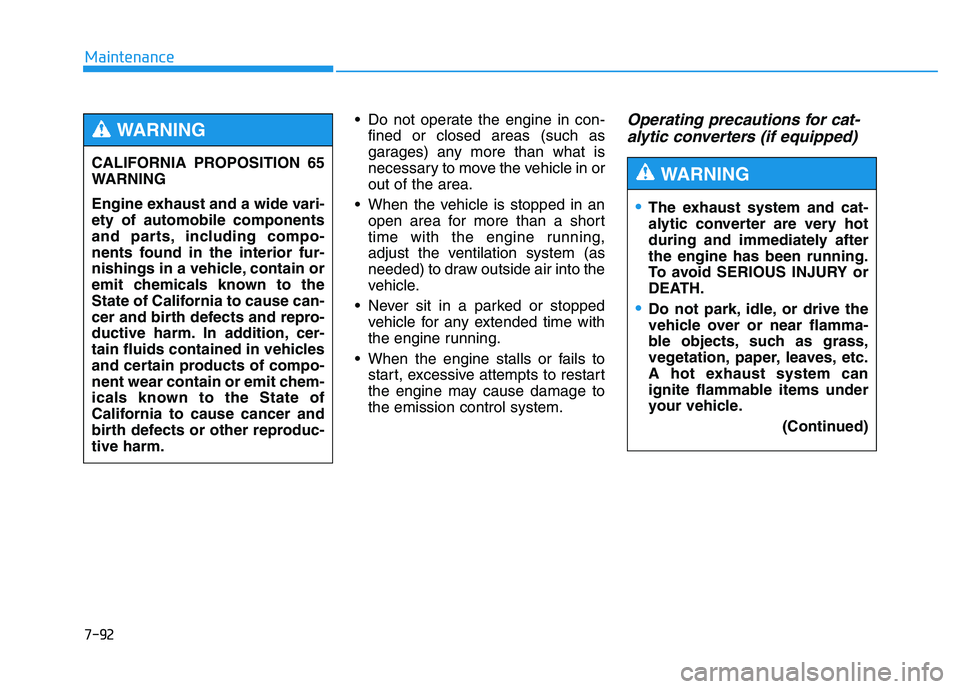
7-92
Maintenance
Do not operate the engine in con-fined or closed areas (such as
garages) any more than what is
necessary to move the vehicle in orout of the area.
When the vehicle is stopped in an open area for more than a short
time with the engine running,
adjust the ventilation system (as
needed) to draw outside air into the
vehicle.
Never sit in a parked or stopped vehicle for any extended time with
the engine running.
When the engine stalls or fails to start, excessive attempts to restart
the engine may cause damage tothe emission control system.Operating precautions for cat-
alytic converters (if equipped)
The exhaust system and cat-
alytic converter are very hot
during and immediately afterthe engine has been running.
To avoid SERIOUS INJURY or
DEATH.
Do not park, idle, or drive the
vehicle over or near flamma-
ble objects, such as grass,
vegetation, paper, leaves, etc.
A hot exhaust system can
ignite flammable items under
your vehicle.
(Continued)
WARNING CALIFORNIA PROPOSITION 65
WARNING
Engine exhaust and a wide vari- ety of automobile components
and parts, including compo-
nents found in the interior fur-
nishings in a vehicle, contain or
emit chemicals known to the
State of California to cause can-
cer and birth defects and repro-
ductive harm. In addition, cer-
tain fluids contained in vehicles
and certain products of compo-
nent wear contain or emit chem-
icals known to the State of
California to cause cancer and
birth defects or other reproduc-tive harm.
WARNING
Page 523 of 542

7-93
7
Maintenance
Your vehicle is equipped with a cat-
alytic converter emission control
device.
To prevent damage to the catalytic
converter and to your vehicle, take
the following precautions:
Use only UNLEADED FUEL
for gasoline engines.
Do not operate the vehicle when there are signs of
engine malfunction, such as
misfire or a noticeable loss of
performance.
Do not misuse or abuse the
engine. Examples of misuseare coasting with the engineoff and descending steep
grades in gear with the engine
off.
Do not operate the engine at
high idle speed for extended
periods (5 minutes or more).(Continued)
CAUTION
(Continued)
Keep away from the exhaust
system and catalytic convert-
er or you may get burned.
Also, Do not remove the heat
sink around the exhaust sys-
tem, do not seal the bottom of
the vehicle, and do not coat
the vehicle for corrosion con-
trol. It may present a fire risk
under certain conditions.
(Continued)
Do not modify or tamper with
any part of the engine or
emission control system. Allinspections and adjustments
must be made by an author-
ized HYUNDAI dealer.
Avoid driving with extremely
low fuel level. If you run out of
gasoline, it could cause theengine to misfire and result in
excessive loading of the cat-
alytic converter.
Page 524 of 542
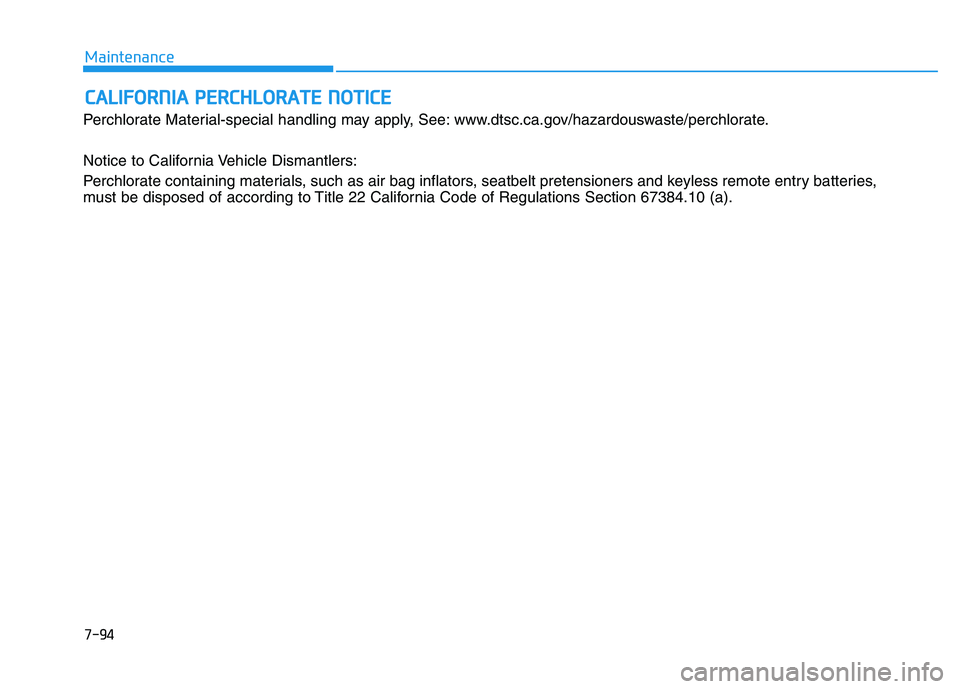
7-94
Maintenance
CCAA LLIIFF OO RRNN IIAA PP EERR CCHH LLOO RRAA TTEE NN OO TTIICC EE
Perchlorate Material-special handling may apply, See: www.dtsc.ca.gov/hazardouswaste/perchlorate.
Notice to California Vehicle Dismantlers:
Perchlorate containing materials, such as air bag inflators, seatbelt pretensioners and keyless remote entry batteries,
must be disposed of according to Title 22 California Code of Regulations Section 67384.10 (a).
Page 525 of 542
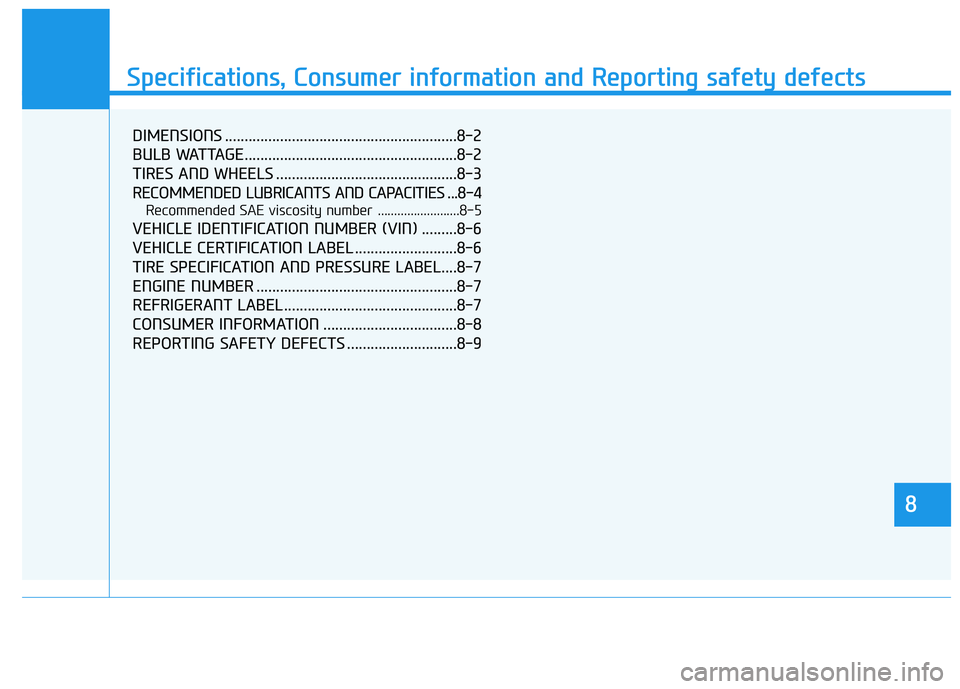
888
Specifications & Consumer information
8
Specifications, Consumer information and Reporting safety defects
8
DIMENSIONS ...........................................................8-2
BULB WATTAGE......................................................8-2
TIRES AND WHEELS ..............................................8-3
RECOMMENDED LUBRICANTS AND CAPACITIES...8-4
Recommended SAE viscosity number .........................8-5
VEHICLE IDENTIFICATION NUMBER (VIN) .........8-6
VEHICLE CERTIFICATION LABEL ..........................8-6
TIRE SPECIFICATION AND PRESSURE LABEL....8-7
ENGINE NUMBER ...................................................8-7
REFRIGERANT LABEL............................................8-7
CONSUMER INFORMATION ..................................8-8
REPORTING SAFETY DEFECTS ............................8-9
Page 526 of 542
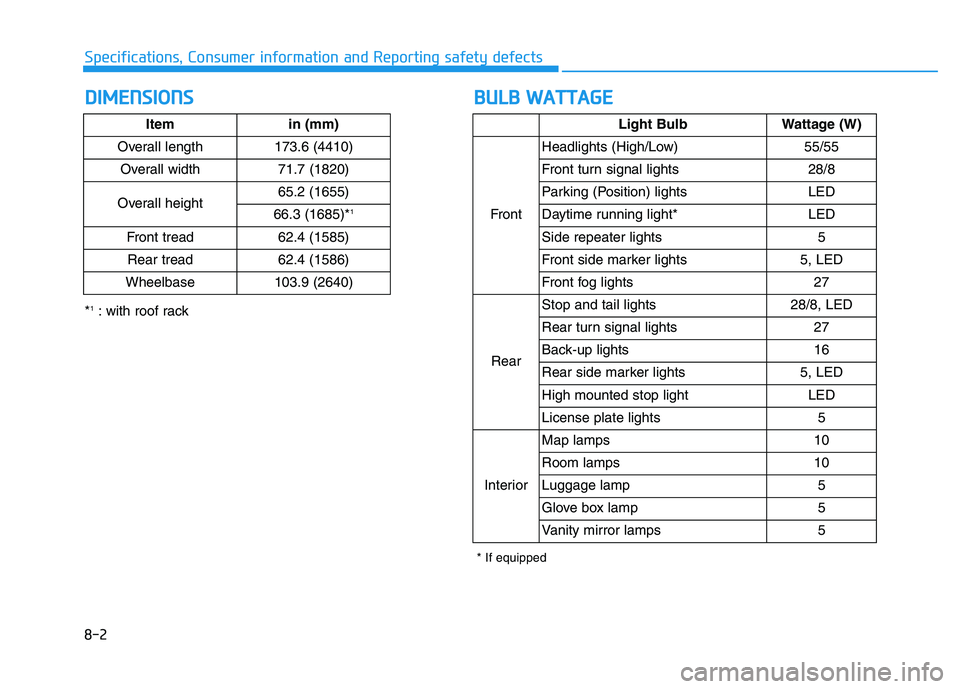
DDIIMM EENN SSIIOO NNSS
8-2
Specifications, Consumer information and Reporting safety defects
*1
: with roof rack
BB UU LLBB WW AATTTTAA GG EE
Item in (mm)
Overall length 173.6 (4410) Overall width 71.7 (1820)
Overall height 65.2 (1655)
66.3 (1685)*
1
Front tread 62.4 (1585) Rear tread 62.4 (1586)
Wheelbase 103.9 (2640)
Light Bulb Wattage (W)
Front Headlights (High/Low) 55/55
Front turn signal lights 28/8
Parking (Position) lights LED
Daytime running light* LED
Side repeater lights 5
Front side marker lights 5, LED
Front fog lights 27
Rear Stop and tail lights 28/8, LED
Rear turn signal lights 27
Back-up lights 16
Rear side marker lights 5, LED
High mounted stop light LED
License plate lights 5
Interior Map lamps 10
Room lamps 10
Luggage lamp 5
Glove box lamp 5
Vanity mirror lamps 5
* If equipped
Page 527 of 542
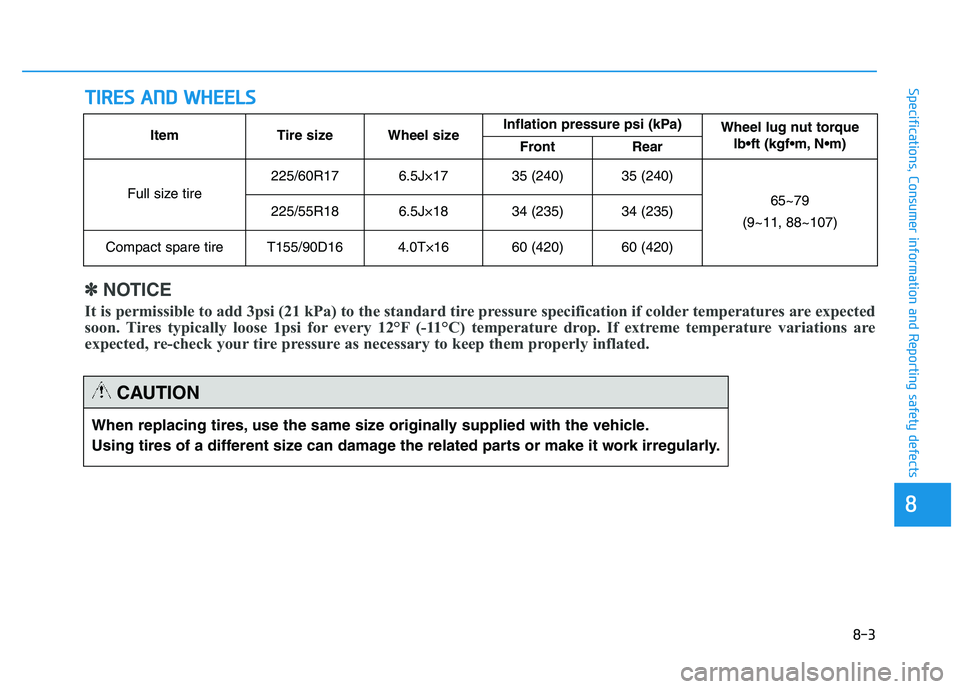
TTIIRR EESS AA NN DD WW HHEEEELLSS
8-3
88
Specifications, Consumer information and Reporting safety defects
Item Tire size Wheel size Inflation pressure psi (kPa)
Wheel lug nut torque
Front Rear
Full size tire 225/60R17 6.5J×17 35 (240) 35 (240)
65~79
(9~11, 88~107)
225/55R18 6.5J×18 34 (235) 34 (235)
Compact spare tire T155/90D16 4.0T×16 60 (420) 60 (420)
When replacing tires, use the same size originally supplied with the vehicle.
Using tires of a different size can damage the related parts or make it work irregularly.
CAUTION
✽✽ NOTICE
It is permissible to add 3psi (21 kPa) to the standard tire pressure specification if cold er temperatures are expected
soon. Tires typically loose 1psi for every 12°F (-11°C) temperature drop. If extreme temperature var iations are
expected, re-check your tire pressure as necessary to keep them properly inflated .
Page 528 of 542
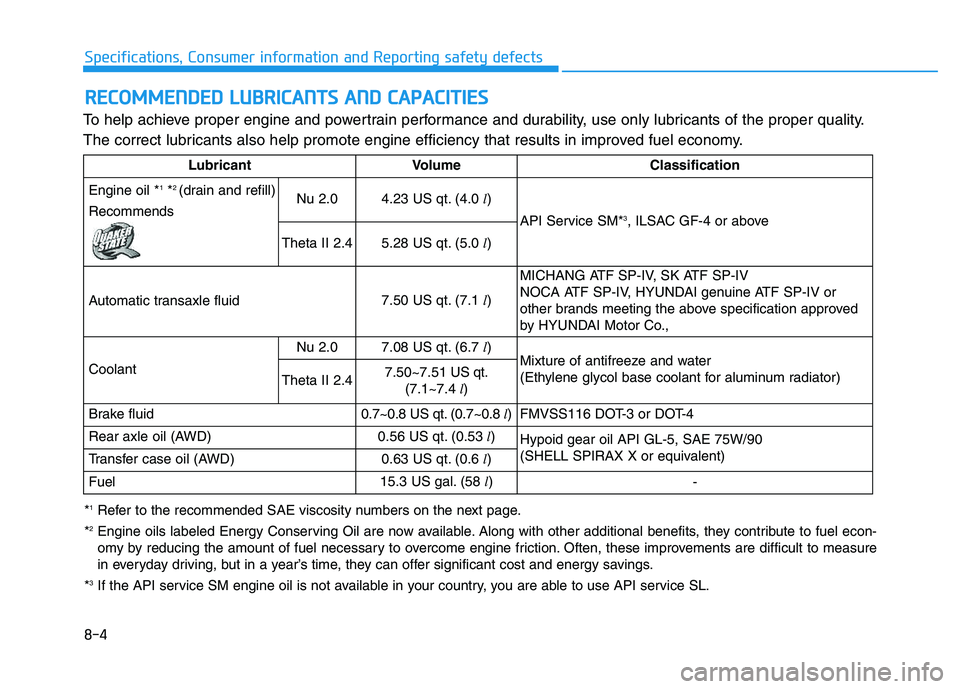
To help achieve proper engine and powertrain performance and durability, use only lubricants of the proper quality.
The correct lubricants also help promote engine efficiency that results in improved fuel economy.
RREECCOO MM MMEENN DDEEDD LL UU BBRRIICC AA NN TTSS AA NN DD CC AA PPAA CCIITT IIEE SS
8-4
Specifications, Consumer information and Reporting safety defects
*1
Refer to the recommended SAE viscosity numbers on the next page.
* 2
Engine oils labeled Energy Conserving Oil are now available. Along with other additional benefits, they contribute to fuel econ-
omy by reducing the amount of fuel necessary to overcome engine friction. Often, these improvements are difficult to measure
in everyday driving, but in a year’s time, they can offer significant cost and energy savings.
* 3
If the API service SM engine oil is not available in your country, you are able to use API service SL.
LubricantVolumeClassification
Engine oil * 1
*2
(drain and refill)
RecommendsNu 2.04.23 US qt. (4.0 l)
API Service SM* 3
, ILSAC GF-4 or above
Theta II 2.45.28 US qt. (5.0 l)
Automatic transaxle fluid7.50 US qt. (7.1 l)
MICHANG ATF SP-IV, SK ATF SP-IV
NOCA ATF SP-IV, HYUNDAI genuine ATF SP-IV or
other brands meeting the above specification approved
by HYUNDAI Motor Co.,
Coolant
Nu 2.07.08 US qt. (6.7 l)Mixture of antifreeze and water
(Ethylene glycol base coolant for aluminum radiator)
Theta II 2.47.50~7.51 US qt.
(7.1~7.4 l)
Brake fluid0.7~0.8 US qt. (0.7~0.8 l)FMVSS116 DOT-3 or DOT-4
Rear axle oil (AWD)0.56 US qt. (0.53 l)Hypoid gear oil API GL-5, SAE 75W/90
(SHELL SPIRAX X or equivalent)
Transfer case oil (AWD)0.63 US qt. (0.6 l)
Fuel15.3 US gal. (58 l)-
Page 529 of 542
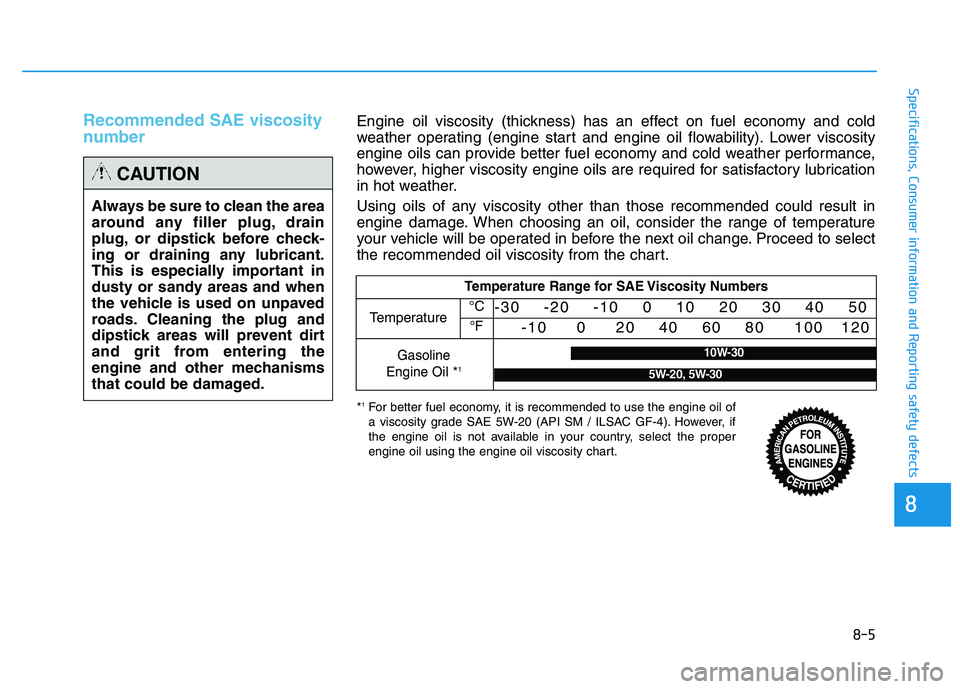
Recommended SAE viscosity
number
8-5
88
Specifications, Consumer information and Reporting safety defects
Always be sure to clean the area
around any filler plug, drain
plug, or dipstick before check-
ing or draining any lubricant.
This is especially important in
dusty or sandy areas and when
the vehicle is used on unpaved
roads. Cleaning the plug and
dipstick areas will prevent dirt
and grit from entering the
engine and other mechanisms
that could be damaged.
CAUTION
Temperature Range for SAE Viscosity Numbers
Temperature
Gasoline
Engine Oil * 1
°C
°F
-30 -20 -10 0 10 20 30 40 50
-10 0 20 40 60 80 100 120
10W-30
5W-20, 5W-30
*1
For better fuel economy, it is recommended to use the engine oil of
a viscosity grade SAE 5W-20 (API SM / ILSAC GF-4). However, if
the engine oil is not available in your country, select the proper
engine oil using the engine oil viscosity chart.
Engine oil viscosity (thickness) has an effect on fuel economy and cold
weather operating (engine start and engine oil flowability). Lower viscosity
engine oils can provide better fuel economy and cold weather performance,
however, higher viscosity engine oils are required for satisfactory lubrication
in hot weather.
Using oils of any viscosity other than those recommended could result in
engine damage. When choosing an oil, consider the range of temperature
your vehicle will be operated in before the next oil change. Proceed to select
the recommended oil viscosity from the chart.
Page 530 of 542
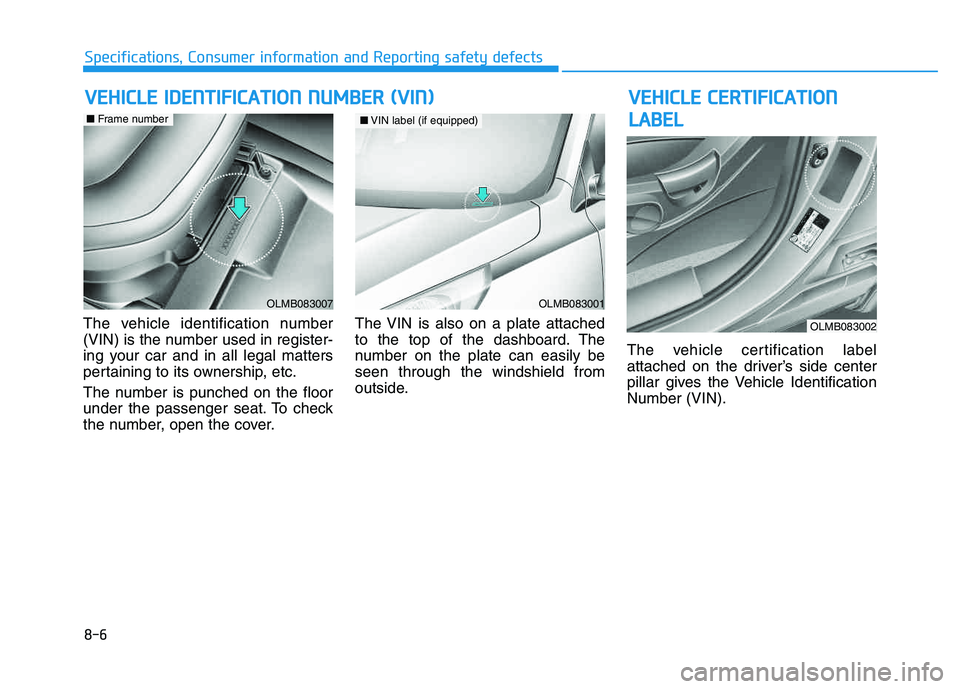
VVEEHH IICC LLEE CC EE RR TTIIFF IICC AA TTIIOO NN
L
L AA BBEELL
The vehicle identification number
(VIN) is the number used in register-
ing your car and in all legal matters
pertaining to its ownership, etc.
The number is punched on the floor
under the passenger seat. To check
the number, open the cover. The VIN is also on a plate attached
to the top of the dashboard. The
number on the plate can easily beseen through the windshield from
outside.
The vehicle certification label
attached on the driver’s side center
pillar gives the Vehicle IdentificationNumber (VIN).
VV
EEHH IICC LLEE IIDD EENN TTIIFF IICC AA TTIIOO NN NN UU MM BBEERR (( VV IINN ))
8-6
Specifications, Consumer information and Reporting safety defects
OLMB083001
■VIN label (if equipped)
OLMB083007
■ Frame number
OLMB083002